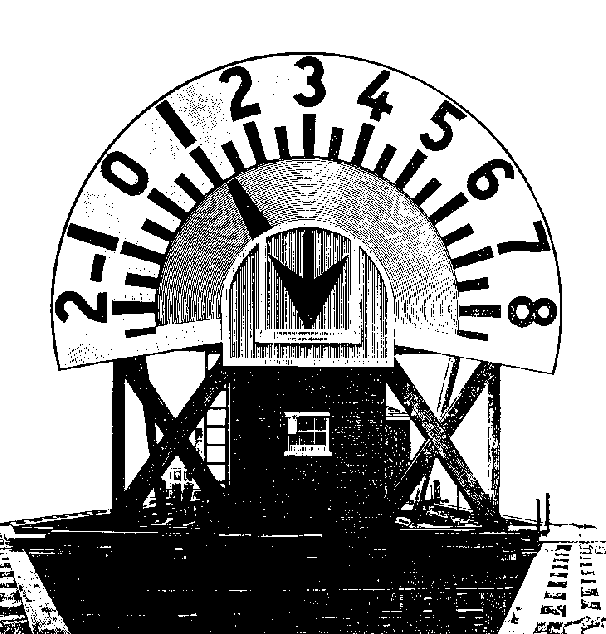History of Tidal Analysis and Prediction

Ship Transit
Early example of a "real-time" tide gauge. Mechanical tide gauges were first used in the United States in the 1850s. This old wooden station, used in 1897 at Fort Hamilton, New York, is one of the earliest examples of a real-time, tide-measuring device. When entering or leaving the port, mariners would view this station through binoculars. The pointer indicates the present level of the water while the vertical arrow indicates whether the tide is rising or falling.
People who live in coastal areas or who look to the sea for their livelihood have been observing the tides and tidal currents for many years. They have used their observations and practical knowledge in a variety of ways to their advantage. For example, it has aided them in timing the sailing of ships to and from port. It has also aided them in maintaining aquaculture and fishery activities in the inter-tidal zone near their shores.
A more theoretical study of tidal phenomena was undertake by notable people from the past. The work of the people highlighted here has formed the basis of present-day tidal analysis and prediction as practiced in the National Ocean Service.
Sir William Thomson (Lord Kelvin) devised the method of reduction of tides by harmonic analysis about the year 1867. The principle upon which the system is based, which is that any periodic motion or oscillation can always be resolved into the sum of a series of simple harmonic motions, is said to have been discovered by Eudoxas as early as 356 B.C., when he explained the apparently irregular motions of the planets by combinations of uniform circular motions. In the early part of the nineteenth century Laplace recognized the existence of partial tides that might be expressed by the cosine of an angle increasing uniformly with the time, and also applied the essential principles of the harmonic analysis to the reduction of high and low waters. Dr. Thomas Young suggested the importance of observing and analyzing the entire tidal curve rather than the high and low waters only. Sir George B. Airy also had an important part in laying the foundation for the harmonic analysis of the tides. To Sir William Thomson, however, we may give the credit for having placed the analysis on a practical basis.
In 1867 the British Association for the Advancement of Science appointed a committee for the purpose of promoting the extension, improvement, and harmonic analysis of tidal observations. The report on the subject was prepared by Sir William Thomson and was published in the Report of the British Association for the Advancement of Science in 1868. Supplementary reports were made from time to time by the tidal committee and published in subsequent reports of the British association. A few years later a committee, consisting of Professors G. H. Darwin and J. C. Adams, drew up a very full report on the subject, which was published in the Report of the British Association for the Advancement of Science in 1883.
Among the American mathematicians who have had an important part in the development of this subject may be named Professor William Ferrel and Dr. Rollin A. Harris, both of whom were associated with the U.S. Coast and Geodetic Survey. The Tidal Researches, by Professor Ferrel, was published in 1874, and additional articles on the harmonic analysis by the same author appeared from time to time in the annual reports of the Superintendent of the Coast and Geodetic Survey. The best known work of Dr. Harris is his Manual of Tides, which was published in several parts as appendices to the annual reports of the Superintendent of the Coast and Geodetic Survey. The subject of the harmonic analysis was treated principally in Part II of the Manual which appeared in 1897.
The methods for the prediction of the tides may be classified as harmonic and nonharmonic. By the harmonic method the elementary constituent tides, represented by harmonic constants, are combined in to a composite tide. By the nonharmonic method the predictions are made by applying to the times of the moon's transits and to the mean height of the tide systems of differences to take account of average conditions and various inequalities due to changes in the phase of the moon and in the declination and parallax of the moon and sun.
Up to and including the year 1884, all tide predictions for the tide tables were computed by means of auxiliary tables and curves constructed from the results of tide observations at the different ports. From 1885 to 1911, inclusively, the predictions were generally made by means of the Ferrel Tide-Predicting machine. From 1912 to 1965, inclusively, they were made by means of the Coast and Geodetic Survey Tide-Predicting Machine No. 2. Without the use of a tide-predicting machine the harmonic method would involve too much labor to be of practical service, but with such a machine the harmonic method has many advantages over the nonharmonic systems.
Predicting machines were superseded in 1966 by the advent of digital electronic computers. Initially these computers were of the large main-frame type. In the late 1980s main-frames were replaced by the growing sophistication of desktop computers. These are now used exclusively by the National Ocean Service in making predictions for the standard ports of this country and at other locations where sufficient observational data exists.